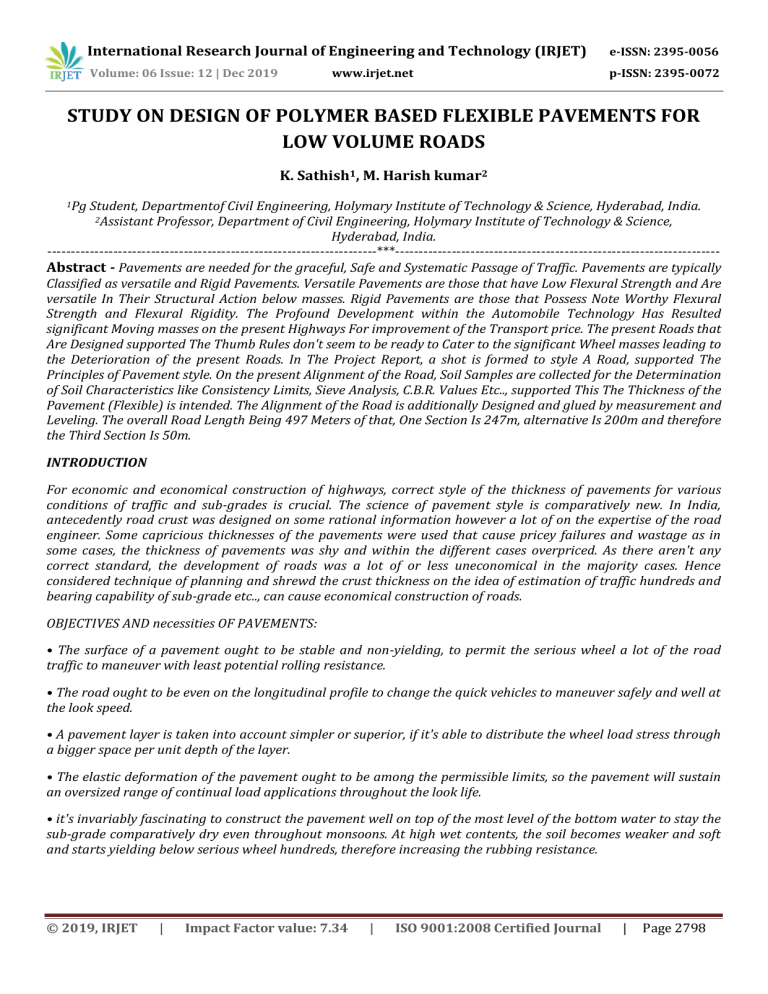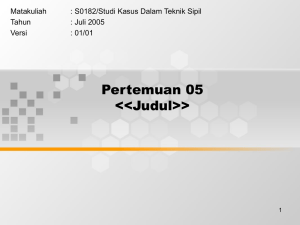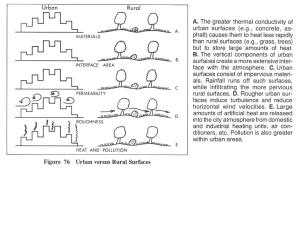IRJET-Study on Design of Polymer based Flexible Pavements for Low Volume Roads
advertisement

International Research Journal of Engineering and Technology (IRJET) e-ISSN: 2395-0056 Volume: 06 Issue: 12 | Dec 2019 p-ISSN: 2395-0072 www.irjet.net STUDY ON DESIGN OF POLYMER BASED FLEXIBLE PAVEMENTS FOR LOW VOLUME ROADS K. Sathish1, M. Harish kumar2 1Pg Student, Departmentof Civil Engineering, Holymary Institute of Technology & Science, Hyderabad, India. 2Assistant Professor, Department of Civil Engineering, Holymary Institute of Technology & Science, Hyderabad, India. ----------------------------------------------------------------------***--------------------------------------------------------------------Abstract - Pavements are needed for the graceful, Safe and Systematic Passage of Traffic. Pavements are typically Classified as versatile and Rigid Pavements. Versatile Pavements are those that have Low Flexural Strength and Are versatile In Their Structural Action below masses. Rigid Pavements are those that Possess Note Worthy Flexural Strength and Flexural Rigidity. The Profound Development within the Automobile Technology Has Resulted significant Moving masses on the present Highways For improvement of the Transport price. The present Roads that Are Designed supported The Thumb Rules don't seem to be ready to Cater to the significant Wheel masses leading to the Deterioration of the present Roads. In The Project Report, a shot is formed to style A Road, supported The Principles of Pavement style. On the present Alignment of the Road, Soil Samples are collected for the Determination of Soil Characteristics like Consistency Limits, Sieve Analysis, C.B.R. Values Etc.., supported This The Thickness of the Pavement (Flexible) is intended. The Alignment of the Road is additionally Designed and glued by measurement and Leveling. The overall Road Length Being 497 Meters of that, One Section Is 247m, alternative Is 200m and therefore the Third Section Is 50m. INTRODUCTION For economic and economical construction of highways, correct style of the thickness of pavements for various conditions of traffic and sub-grades is crucial. The science of pavement style is comparatively new. In India, antecedently road crust was designed on some rational information however a lot of on the expertise of the road engineer. Some capricious thicknesses of the pavements were used that cause pricey failures and wastage as in some cases, the thickness of pavements was shy and within the different cases overpriced. As there aren't any correct standard, the development of roads was a lot of or less uneconomical in the majority cases. Hence considered technique of planning and shrewd the crust thickness on the idea of estimation of traffic hundreds and bearing capability of sub-grade etc.., can cause economical construction of roads. OBJECTIVES AND necessities OF PAVEMENTS: • The surface of a pavement ought to be stable and non-yielding, to permit the serious wheel a lot of the road traffic to maneuver with least potential rolling resistance. • The road ought to be even on the longitudinal profile to change the quick vehicles to maneuver safely and well at the look speed. • A pavement layer is taken into account simpler or superior, if it's able to distribute the wheel load stress through a bigger space per unit depth of the layer. • The elastic deformation of the pavement ought to be among the permissible limits, so the pavement will sustain an oversized range of continual load applications throughout the look life. • it's invariably fascinating to construct the pavement well on top of the most level of the bottom water to stay the sub-grade comparatively dry even throughout monsoons. At high wet contents, the soil becomes weaker and soft and starts yielding below serious wheel hundreds, therefore increasing the rubbing resistance. © 2019, IRJET | Impact Factor value: 7.34 | ISO 9001:2008 Certified Journal | Page 2798 International Research Journal of Engineering and Technology (IRJET) e-ISSN: 2395-0056 Volume: 06 Issue: 12 | Dec 2019 p-ISSN: 2395-0072 www.irjet.net GROUP INDEX METHOD: D.J. Steel urged the thickness needs with the route analysis Board technique supported the cluster index values in 1945. Cluster index worth is associate degree discretional index appointed to the soil varieties in numerical equations supported the % fines, liquid limit and physical property index. GI values of soil vary within the vary of 0 to twenty. The upper the GI worth, weaker is that the soil sub grade and for a continuing worth of traffic volume, the bigger would be the thickness demand of the pavement. The traffic volume in this method is divided into three groups: Traffic volume (commercial vehicles) Light Medium Heavy No. of vehicles/day Less than 50 50 to 300 Over 300 LITERATURE REVIEW Flexible pavements are most popular over cement concrete roads as they need a good advantage that these are often reinforced and improved little by little with the expansion of traffic and additionally their surfaces can be processed and recycled for rehabilitation. The FLEXIBLE pavements are more cost-effective additionally with reference to initial investment and maintenance. Though rigid pavement is pricey however have less maintenance and having smart style amount. The economic half is administered for the look pavement of a locality by victimization the results obtained by choice methodology and their corresponding element layer thickness. Saurabh religious belief, Dr. Y. P. Joshi, S. S. Goliya: This paper discusses regarding the look ways that are historically being followed and examines the “Design of rigid and FLEXIBLE pavements by numerous methods & their analysis by every method” D. S. V. Prasad and G. V. R. Prasada Raju: This paper investigates the performance of FLEXIBLE pavement on expansive soil sub grade victimization gravel/flyash as sub base course with waste tyre rubber as a reinforcing material. it absolutely was determined that from the laboratory check results of direct shear and cosmic microwave background, the gravel sub base shows higher performance as compared to flyash sub base with totally different percentages of waste tyre rubber as reinforcing material. Cyclic load tests also are administered within the laboratory by putting a circular metal plate on the model FLEXIBLE pavements. it absolutely was determined that the most load carrying capability related to less price of rebound deflection is obtained for gravel bolstered sub base compared to flyash reinforced sub base. B.S. Bharathi et al during this project a shot is created to style a model road for a new engineered up colony supported the trendy principles of pavement design. On the prevailing alignment of the road, soil samples are collected for the determination of soil characteristics like consistency limits, sieve analysis, C.B.R values, etc. supported this, the thickness of the pavement (flexible) is meant. The alignment of the road is additionally designed and glued by measurement and levelling. CHAPTER 3 SUMMARY In this project work, an attempt is made to incorporate latest techniques of geometric design, pavement design for a road for an existing colony which 2 km away from Car Shed Junction, P.M.Palem. The IRC specifications are based on rational thinking, the proposed road is safe in both geometrics as well as pavement design. © 2019, IRJET | Impact Factor value: 7.34 | ISO 9001:2008 Certified Journal | Page 2799 International Research Journal of Engineering and Technology (IRJET) e-ISSN: 2395-0056 Volume: 06 Issue: 12 | Dec 2019 p-ISSN: 2395-0072 www.irjet.net It is also proposed to design a flexible pavement by Group Index method and CBR method. Some more methods are available in the design of flexible pavement, which are much advanced like California resisting value method, Mc leod method, triaxial method and Burnister method. Because of the limitations of time and scope, only GI method and CBR method are adopted. To have a practical concept of estimation analysis, an attempt is made to estimate the quantities of earth work of flexible pavement. REFERENCES [1] American Society for Testing and Materials 2009, Standard Test Method for Resistance to Degradation of Large-Size Coarse Aggregate by Abrasion and Impact in the Los Angles Machine, ASTM C535, USA. [2] American Society for Testing and Material 2001, Standard Specification for Chemical Admixture for concrete, ASTMC494, USA. [3] American Society for testing and materials 2001, Standard Specification for Silica Fume Used in cementitious Mixtures, ASTM CI240, USA. [4] American Society for Testing and materials, 2011, Standard specification fir concrete aggregate, ASTM C33, USA. [5] B. Kournmpains, A. Papadopoulos, K. Moustakes, M. Staylianous, K.J. Haralambous, [9] B.G. Fonteboa, F.M. Abella, Shear strength of recycled concrete beams, J. Constr. Build. Mater. 21 (2007) 887-893. [6] C. Poon et al, Influence of Moisture state of natural and recycled aggregates on the slump and compressive strength of concrete, Cem. Concr. Res. 34 (2004) 31-36. [7] D. Kong, T. Lei, J. Zheng, Ch. J. Jiang, J. Jiang, Effect and mechanism of surface coating pozzalanics materials around aggregate on properties and ITZ microstructure of recycled aggregate concrete, constr. Build. Mater. 24 (2010) 701-708. © 2019, IRJET | Impact Factor value: 7.34 | ISO 9001:2008 Certified Journal | Page 2800



